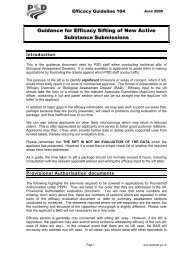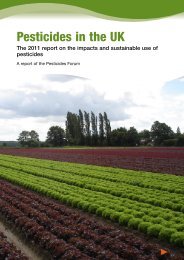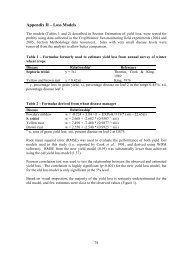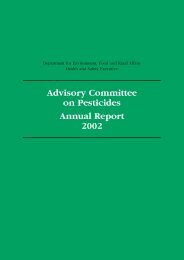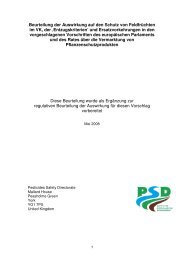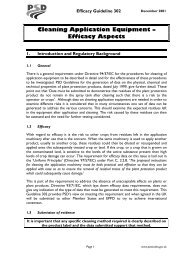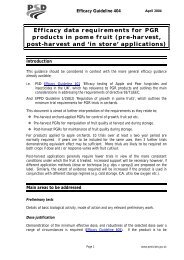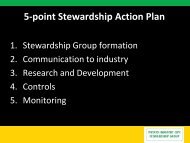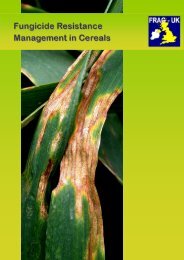Advisory Committee on Pesticides Annual Report 2001
ACP Annual Report 2001 - Pesticides Safety Directorate
ACP Annual Report 2001 - Pesticides Safety Directorate
Create successful ePaper yourself
Turn your PDF publications into a flip-book with our unique Google optimized e-Paper software.
Secti<strong>on</strong> F: Other items c<strong>on</strong>sidered during the year<br />
to grain. Organophosphates c<strong>on</strong>tinued to account for the majority of pesticides<br />
used in grain stores and in the current survey they accounted for 85 percent<br />
of the total weight of pesticides applied.<br />
Other Items<br />
Aquatic risk management opti<strong>on</strong>s<br />
In the UK, buffer z<strong>on</strong>es are required for some products to prevent an<br />
unacceptable risk of damage to aquatic life. A buffer z<strong>on</strong>e is a strip of land<br />
adjacent to surface water left untreated with that product. The size of the<br />
buffer z<strong>on</strong>e may be reduced under some circumstances following an<br />
appropriate Local Envir<strong>on</strong>mental Risk Assessment c<strong>on</strong>ducted under the<br />
relevant LERAP scheme. However, at present the maximum size of buffer z<strong>on</strong>e<br />
that could be required for a product approved for use <strong>on</strong> arable crops is five<br />
metres. There are different risk management opti<strong>on</strong>s used in other European<br />
Member States resulting in some differences in the range of products available<br />
to growers across Europe. The ACP c<strong>on</strong>sidered a number of the approaches<br />
adopted by other Member States, some of which allow for buffer z<strong>on</strong>es in<br />
arable crops of greater than five metres. It also c<strong>on</strong>sidered the results of a<br />
limited survey giving evidence <strong>on</strong> compliance with the existing risk<br />
management strategy in the UK. Overall, members c<strong>on</strong>cluded that while<br />
larger buffer z<strong>on</strong>es in arable crops would be capable of providing risk<br />
mitigati<strong>on</strong>, they would require better evidence of compliance with the<br />
current arrangements before c<strong>on</strong>sidering any increase in the maximum<br />
size of buffer z<strong>on</strong>es in the arable sector.<br />
75<br />
Bioavailability of triazophos for treated apples<br />
In 1998, PSD/MAFF initiated a research project to investigate the bioavailability<br />
of the organophosphorus compound triazophos. The primary aim was to<br />
compare the results in animals administered triazophos in corn oil with those<br />
receiving a similar dose from pureed apples treated in line with agricultural<br />
practice. The corn oil exposure was typical of that used in toxicity studies<br />
used to derive acute reference doses, with the apple exposure representing<br />
human exposures. If there were differences between the results for the<br />
vehicles there might be a need to introduce an appropriate correcti<strong>on</strong> into risk<br />
assessments.<br />
The peak levels and ‘area under the curve’ (AUC) values for total plasma<br />
radioactivity were broadly similar, whether the triazophos was present as an<br />
incurred residue in orally dosed apple puree, or present in orally dosed corn<br />
oil. The <str<strong>on</strong>g>Committee</str<strong>on</strong>g> noted that the results of the research showed similar<br />
absorpti<strong>on</strong> patterns and plasma profiles for both preparati<strong>on</strong>s. The <str<strong>on</strong>g>Committee</str<strong>on</strong>g>




